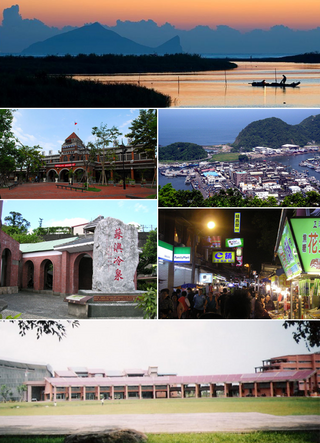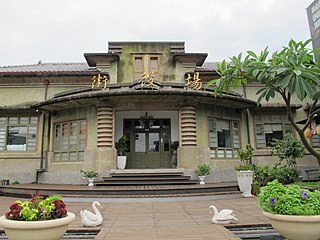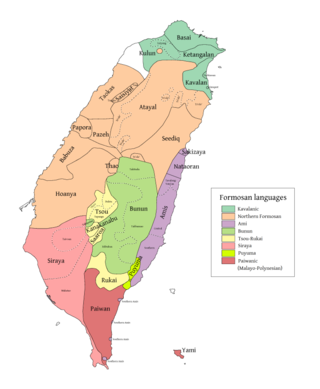
Taiwanese indigenous peoples, also known as Native Taiwanese, Formosan peoples, Austronesian Taiwanese, Yuanzhumin or Gaoshan people, and formerly as Taiwanese aborigines, are the indigenous peoples of Taiwan, with the nationally recognized subgroups numbering about 569,000 or 2.38% of the island's population. This total is increased to more than 800,000 if the indigenous peoples of the plains in Taiwan are included, pending future official recognition. When including those of mixed ancestry, such a number is possibly more than a million. Academic research suggests that their ancestors have been living on Taiwan for approximately 6,500 years. A wide body of evidence suggests that the Taiwanese indigenous peoples had maintained regular trade networks with numerous regional cultures of Southeast Asia before the Han Chinese colonists began settling on the island from the 17th century, at the behest of the Dutch colonial administration and later by successive governments towards the 20th century.

Yilan County, alternately spelled I-lan, is a county in northeastern Taiwan, Republic of China. Yilan is northernmost county on the island of Taiwan with a population 449,510. Its seat is located in Yilan City.

Sinhua District, alternatively spelled Xinhua, is a suburban district in central Tainan, Taiwan.

Jiaoxi Township or Chiaohsi Township is a rural township in the northern section of Yilan County, Taiwan.

The Sinkang Manuscripts are a series of leases, mortgages, and other commerce contracts written in the Sinckan, Taivoan, and Makatao languages. Among Han Chinese, they are commonly referred to as the "barbarian contracts". Some are written only in a Latin-based script, considered the first script to be developed in Taiwan itself, while others were bilingual with adjacent Han writing. Currently there are approximately 140 extant documents written in Sinckan; they are important in the study of Siraya and Taivoan culture, and Taiwanese history in general although there are only a few scholars who can understand them.

The Siraya people are a Taiwanese indigenous people. The Siraya settled flat coastal plains in the southwest part of the island of Taiwan and corresponding sections of the east coast; the area is identified today with Tainan City and Taitung County. At least four communities make up the group: Mattauw, Soelangh, Baccloangh, and Sinckan. The first four communities correspond to the modern-day districts of Madou, Jiali, Shanhua, and Sinshih, respectively.

Siraya is a Formosan language spoken until the end of the 19th century by the indigenous Siraya people of Taiwan, derived from Proto-Siraya. Some scholars believe Taivoan and Makatao are two dialects of Siraya, but now more evidence shows that they should be classified as separate languages.

Tiantai County is located in Taizhou, Zhejiang, People's Republic of China. Residents mainly speak the Tiantai dialect.

Taivoan or Taivuan, is a Formosan language spoken until the end of the 19th century by the indigenous Taivoan people of Taiwan. Taivoan used to be regarded as a dialect of Siraya, but now more evidence has shown that they should be classified as separate languages. The corpora previously regarded as Siraya like the Gospel of St. Matthew and the Notes on Formulary of Christianity translated into "Siraya" by the Dutch people in the 17th century should be in Taivoan majorly.

Plains indigenous peoples, previously called plain aborigines, are Taiwanese indigenous peoples originally residing in lowland regions, as opposed to Highland indigenous peoples. Plains indigenous peoples consist of anywhere from eight to twelve individual groups, or tribes, rather than being a single ethnic group. They are part of the Austronesian family. Beginning in the 17th century, plains indigenous peoples have been heavily influenced by external forces from Dutch, Spanish, and Han Chinese immigration to Taiwan. This ethnic group has since been extensively assimilated with Han Chinese language and culture; they have lost their cultural identity, and it is almost impossible without careful inspection to distinguish plains indigenous peoples from Taiwanese Han people.

The Taivoan or Tevoranghpeople or Shisha, also written Taivuan and Tevorang, Tivorang, Tivorangh, are a Taiwanese indigenous people.

Dazhuang is a community located in Tungli Village, Fuli Township in Hualien County, Taiwan. Dazhuang used to be an old community of Amis, until 1845 when some plain indigenous people started to migrate from Southern Taiwan to here. It was the most populous community in Fuli between Qin dynasty and Japanese occupation period, and so called the name Tuā-tsng, which means "a big village" in Taiwanese.

Guanshan Village, also called by the locals as Alikuan or Aliguan, is an indigenous Taivoan community located in Jiaxian District in Kaohsiung City, Taiwan. As driven by Chinese immigrants and Siraya, Taivoan people started to emigrate from Tainan to Kaohsiung in the early 18th century, and eventually founded the community in 1744. Alikuan was also an important battle field in Tapani incident in 1915.
Saqacengalj is an abandoned or so-called former indigenous settlement of a Paiwan tribe in Gaoshi Village, Mudan Township, Pingtung County, Taiwan. The term “Saqacengalj” has the meaning of “a tool for chiseling slate,” and the site is believed to be the first settlement of the Paiwan people when they moved to Hengchun. Saqacengal, dating back to 500-600 years ago, is about 200-300 meters above sea level, and covers an area of 3.5 hectares. There were 6-7 waves of migration before the site was abandoned, and the Paiwan people finally settled down at the location of Gaoshi Village for the last migration around 50 years ago. The location of Saqacengalj is about 7 kilometers away from the current settlement of Gaoshi Village. There are still about 83 slate house structures at Saqacengalj, which are arranged in parallel rows along the mountain steps
Banana colloquial speech or Banana colloquial dialect is a creole language or cant spoken among the Plain indigenous peoples since the Japanese occupation period to the present in hill areas of southern Taiwan, especially Kaohsiung and Tainan. It is primarily a mixture of Taiwanese, and sometime Taivoan language in Jiasian, Kaohsiung.

A Kong-kài, literally "the Public Hall" in Taiwanese Hokkien, is a temple or shrine where indigenous peoples like the Siraya, Taivoan or Makatao hold rituals for their ancestral spirits. Historical records indicate that in the past, the Kong-kài served other functions, including a men's gathering place or a public meeting place for discussions and decision-making.
















